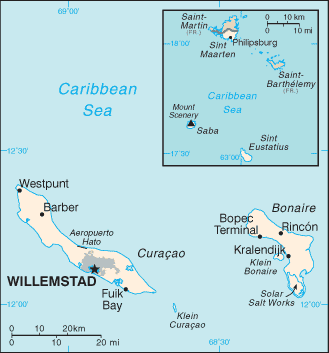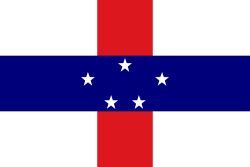Netherlands Antilles
Related Categories:
 Netherlands Antilles - Fotw
Netherlands Antilles - FotwThe colours red, white and blue refer to the Dutch flag, the five stars symbolise the five islands.
www.fotw.us/flags/an.html Netherlands Antilles - wikipedia.org
The Netherlands Antilles is to be disbanded on December 15, 2008. Two new associated states within the Kingdom of the Netherlands would be formed, Curaçao and Sint Maarten.
en.wikipedia.org/
In 1845 the Dutch Windward islands united with Curaçao, Bonaire, and Aruba in a political unit. The abolition of slavery hurt the islands' economy until the 20th century, when oil was discovered off the shores of Venezuela and a refinery was established on Curaçao. In addition, during the same period, an offshore financial sector was created to serve Dutch business interests. Since 1945, the federation of the Netherlands Antilles--Curacao, Bonaire, Saba, Sint Eustatius, and Sint Maarten--have been autonomous in internal affairs. Aruba was part of this federation until January 1, 1986, when it gained status apart within the Kingdom of the Netherlands.
About 85% of Curacao's population is of African derivation. The remaining 15% is made up of various races and nationalities, including Dutch, Portuguese, North Americans, natives from other Caribbean islands, Latin Americans, Sephardic Jews, Lebanese, and Asians. Roman Catholicism predominates, but several other religions are represented, which include Anglican, Jewish, Muslim, Protestant, Mormon, Baptist, Islam, and Hindu. The Jewish community is the oldest in the Western Hemisphere, dating back to 1634. While faltering economic conditions caused the Netherlands Antilles to experience high rates of migration by citizens to Holland from 1998-2002, this trend has largely been reversed in recent years.
www.state.gov/r/
Introduction
About
Contact
Symbols in The News
Interpret this Symbol
AAC
African
AI
Alchemy
Alphabets
Ancient
Animal Symbolism
Architecture
Art
Articles
Astrology
Baha'i
Blissymbolics
Blueprint Symbols
Buddhist
Celtic Symbols
Cemetery
Chinese Symbols
Christian
Circle
City
Codes
Color
Conlangs
Crop Circles
Danger
Da Vinci Code
Designing Logos
Dictionaries
Dreams
Education
Egyptian Symbols
Electrical
Emoticons
Find Images
Fonts
Food
Fraternity
Hamsa
Healing
Heraldry
Hermetic
Highway Signs
Hindu
History
Hobo
Holiday
Icons
iConji
Islamic
Jain Symbols
Japanese, Kanji
Jewish
Justice
Law
Literary Symbolism
Mandalas
Map
Masonic
Math, Number
Meaning of Names
Medical
Middle East
Military
Miscellaneous
Money
Music
Mythology
Native American
Playing Cards
Power
Psychology
QiQiiKhu
Reiki
Religious
Runes, Norse
Sacred Geometry
Scientific
Science Fiction
Sorority
Sports
Symbols in the News
Tattoos
ThirteenSymbols
Tree of Life
Ursprache
Videos
Visual Languages
Weather
Web Codes
Wicca
Words
Writing Systems
Braille
Coinherence
Coptic
Cuneiform
Easter Island
Etruscan
Happy Human
Hebrew
Kokopelli
Linear B
Lotus
Love Symbols
Mandorla
Moon Alphabet
Nine Pointed Star
Om
Oz
Phonetic
Scarab Beetle
Silent
Theosophy
Unifon
About
Contact
Symbols in The News
Interpret this Symbol
AAC
African
AI
Alchemy
Alphabets
Ancient
Animal Symbolism
Architecture
Art
Articles
Astrology
Baha'i
Blissymbolics
Blueprint Symbols
Buddhist
Celtic Symbols
Cemetery
Chinese Symbols
Christian
Circle
City
Codes
Color
Conlangs
Crop Circles
Danger
Da Vinci Code
Designing Logos
Dictionaries
Dreams
Education
Egyptian Symbols
Electrical
Emoticons
Find Images
Fonts
Food
Fraternity
Hamsa
Healing
Heraldry
Hermetic
Highway Signs
Hindu
History
Hobo
Holiday
Icons
iConji
Islamic
Jain Symbols
Japanese, Kanji
Jewish
Justice
Law
Literary Symbolism
Mandalas
Map
Masonic
Math, Number
Meaning of Names
Medical
Middle East
Military
Miscellaneous
Money
Music
Mythology
Native American
Playing Cards
Power
Psychology
QiQiiKhu
Reiki
Religious
Runes, Norse
Sacred Geometry
Scientific
Science Fiction
Sorority
Sports
Symbols in the News
Tattoos
ThirteenSymbols
Tree of Life
Ursprache
Videos
Visual Languages
Weather
Web Codes
Wicca
Words
Writing Systems
Braille
Coinherence
Coptic
Cuneiform
Easter Island
Etruscan
Happy Human
Hebrew
Kokopelli
Linear B
Lotus
Love Symbols
Mandorla
Moon Alphabet
Nine Pointed Star
Om
Oz
Phonetic
Scarab Beetle
Silent
Theosophy
Unifon

